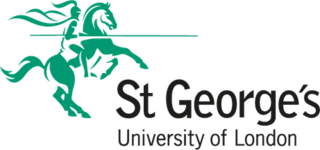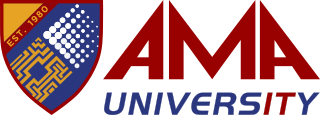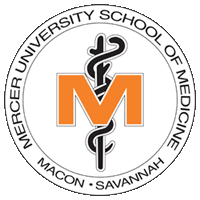
Problem-based learning (PBL) is a teaching method in which students learn about a subject through the experience of solving an open-ended problem found in trigger material. The PBL process does not focus on problem solving with a defined solution, but it allows for the development of other desirable skills and attributes. This includes knowledge acquisition, enhanced group collaboration and communication.

St George's, University of London, legally St George's Hospital Medical School, is a public university in Tooting, South London, England, and is a member institution of the federal University of London. In August 2024, St George's will merge with City, University of London to form City St George's, University of London.

Dissection is the dismembering of the body of a deceased animal or plant to study its anatomical structure. Autopsy is used in pathology and forensic medicine to determine the cause of death in humans. Less extensive dissection of plants and smaller animals preserved in a formaldehyde solution is typically carried out or demonstrated in biology and natural science classes in middle school and high school, while extensive dissections of cadavers of adults and children, both fresh and preserved are carried out by medical students in medical schools as a part of the teaching in subjects such as anatomy, pathology and forensic medicine. Consequently, dissection is typically conducted in a morgue or in an anatomy lab.

AMA Computer University, also known as AMA University or simply AMA, is a private, nonsectarian, for-profit university in Quezon City, Philippines.

In the United Kingdom, medical school generally refers to a department within a university which is involved in the education of future medical practitioners. All leading British medical schools are state-funded and their core purpose is to train doctors on behalf of the National Health Service. Courses generally last four to six years: two years of pre-clinical training in an academic environment and two to three years clinical training at a teaching hospital and in community settings. Medical schools and teaching hospitals are closely integrated. The course of study is extended to six years if an intercalated degree is taken in a related subject.

Lyceum of the Philippines University, also referred to by its acronym LPU, is a private, non-sectarian, coeducational higher education institution located at intramuros in the City of Manila, Philippines. It was founded in 1952 by José P. Laurel, who was the third president of the Republic of the Philippines.
Imperial College School of Medicine (ICSM) is the undergraduate medical school of Imperial College London in England and one of the United Hospitals. It is part of the college's Faculty of Medicine and was formed by the merger of several historic medical schools. It's core campuses are located at South Kensington, St Mary's, Charing Cross, Hammersmith and Chelsea and Westminster. The school ranked 3rd in the world for medicine in the 2022 Times Higher Education World University Rankings.

Medical education is education related to the practice of being a medical practitioner, including the initial training to become a physician and additional training thereafter.

The Emilio Aguinaldo College is a private university based in Manila, Philippines.

The University of Santo Tomas Faculty of Medicine and Surgery (USTFMS) is the medical school of the University of Santo Tomas, the oldest and largest Catholic university in Manila, Philippines.
A prosection is the dissection of a cadaver or part of a cadaver by an experienced anatomist in order to demonstrate for students anatomic structure. In a dissection, students learn by doing; in a prosection, students learn by either observing a dissection being performed by an experienced anatomist or examining a specimen that has already been dissected by an experienced anatomist.
The UC Berkeley-UCSF Joint Medical Program (JMP) is a joint degree program in the University of California system between the UC Berkeley School of Public Health and the UCSF School of Medicine. Students spend their pre-clerkship years at UC Berkeley engaging in a unique medical curriculum centered around student-led inquiry while simultaneously earning a master's degree (MS) in the Health and Medical Sciences at Berkeley Public Health. After two and a half years, students move across the Bay to UCSF to finish their medical education and receive their medical doctorate (MD).
The University of Newcastle School of Medicine, located at the University of Newcastle, is one of eight medical schools in Australia that offers an undergraduate medical degree. The first cohort of medical students began in 1978 and the school has educated more Indigenous medical students than any other University in Australia. Led by foundational Dean and psychiatrist David Maddison, the new school led a major change in medical education in Australia in the late 1970s by introducing Problem-based learning, early clinical skills acquisition, community orientation, and the addition of personal qualities evaluation to the student selection process. A focus on rural medical experience has been in place for many years, and the school now offers its medical program as a partnership with the University of New England, Hunter New England Health and Northern Sydney Central Coast Health. Known as the Joint Medical Program (JMP) it is the first jointly run medical program in Australia.
Samy A. Azer is an Egyptian-born Australian physician author and medical educator who has contributed to medical education internationally.

Howard S. Barrows was an American physician and medical educator who was Professor Emeritus at the Southern Illinois University School of Medicine where he had previously served as Associate Dean for Educational Affairs and Chair of Medical Education. Trained as a neurologist, Barrows is best known today for his many innovations in medical education, particularly teaching using Problem-Based Learning (PBL), developed while he was a professor at McMaster University Medical School, assessing clinical skills using simulated patients, and studying clinical reasoning using stimulated recall techniques.

Mercer University School of Medicine (MUSM) is the graduate medical school of Mercer University and a component of the Mercer University Health Sciences Center. It was founded in 1982 in Macon, Georgia, United States, and in 2008 opened a second campus in Savannah, Georgia with either site allowing students to complete all four requisite years of medical training. In 2012 MUSM developed a third site in Columbus, Georgia at which students could elect to complete their third and fourth years of training. In 2021, the Columbus transitioned to a full four-year campus.

FMH College of Medicine and Dentistry, established in 2001, is a private college of medicine and dentistry located in Shadman, Lahore, Punjab, Pakistan. The college is part of the Fatima Memorial System, accredited by the Pakistan Medical and Dental Council and registered with the World Health Organization, Avicenna Directories and International Medical Education Directory. It is affiliated with the University of Health Sciences, Lahore.

The Michael G. DeGroote School of Medicine, known as the McMaster University School of Medicine prior to 2004, is the medical school of McMaster University in Hamilton, Ontario, Canada. It is operated by the McMaster Faculty of Health Sciences. It is one of two medical programs in Canada, along with the University of Calgary, that operates on an accelerated 3-year MD program, instead of the traditional 4-year MD program.
Lancaster Medical School (LMS) is located in Lancaster, Lancashire in North West England and is part of the Faculty of Health and Medicine at Lancaster University. It is currently the UK's newest public medical school, with its first graduates, a cohort of 31, graduating in 2011. The current head of the medical school is Professor Marina Anderson.

The Virginia Tech Carilion School of Medicine is a public medical school of Virginia Tech and located in Roanoke, Virginia. The medical school is associated with the Fralin Biomedical Research Institute. Formed as a public–private partnership with the Carilion Clinic, the medical school grants the Doctor of Medicine (M.D.) degree to its graduates. Initially a private institution from 2008 to 2018, the medical school became an official college of Virginia Tech in 2018.

















